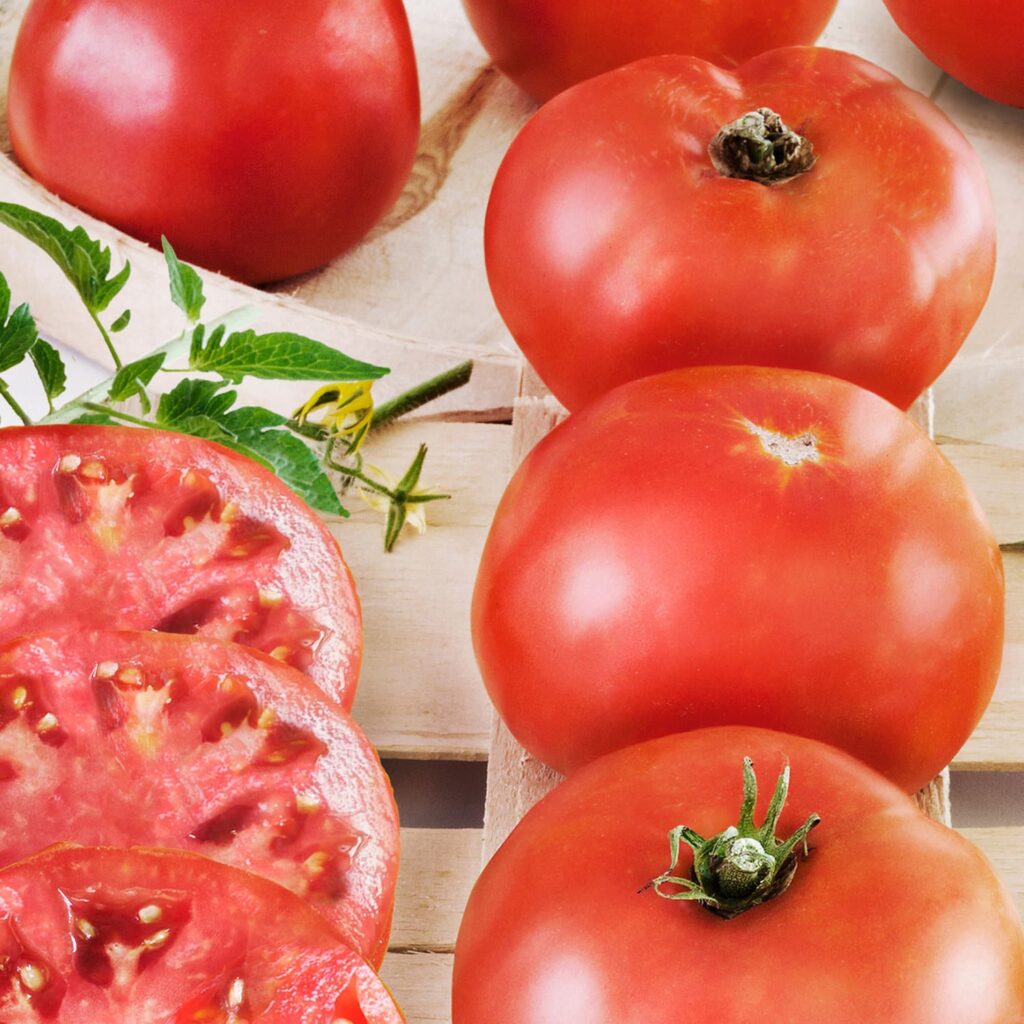A single big boy tomato plant produces around 20 to 30 fruit per season. The yield depends on several factors such as the growing conditions, care, and variety of the plant.
Tomatoes are among the most popular vegetables grown in home gardens across the world. These delicious fruits are full of nutrition and incredibly versatile in the kitchen. Big boy tomatoes are a favorite tomato cultivar among many gardeners due to their large size, sweet flavor, and juicy texture.
If you are planning to grow big boy tomatoes in your garden, you may be wondering how many fruits you can expect to harvest from each plant. The answer is not precise, but generally, a single big boy tomato plant yields around 20 to 30 fruit per growing season. The yield depends on several factors such as the growing conditions, care, and variety of the plant. In this article, we will discuss some essential factors that influence big boy tomato plant yield and how to improve your harvest.

Credit: gardening.org
Understanding The Factors That Determine Tomato Yield
Have you ever wondered why some tomato plants produce a bounty harvest, while others only yield a handful of fruits? Understanding the factors that determine tomato yield is crucial to growing healthy and productive plants. We’ll delve into four crucial factors that affect tomato yield – soil quality and nutrients, sunlight exposure, watering and drainage, and plant pruning and maintenance.
Soil Quality And Nutrients
The soil quality and nutrient supply play a major role in determining the success of your tomato plants. A nutrient-rich soil promotes healthy growth and enhances fruit production. Here are a few key points to keep in mind:
- Choose a well-drained soil that is rich in organic matter. Avoid soil that is too compact or clayey to ensure proper drainage and root development.
- Tomato plants require a steady supply of nutrients, especially nitrogen, potassium, and phosphorous. A suitable fertilizer with these nutrients should be added to the soil before planting.
- Keep ph levels between 6.0 and 6.8, which is the ideal range for tomato plants.
Sunlight Exposure
Tomatoes are sun-loving plants that require at least six to eight hours of sunlight per day. Without enough sunlight exposure, plants may have stunted growth, and the fruits may not ripen properly. Here’s what you need to remember:
- Choose a planting location with maximum sunlight exposure. Your tomato plants should receive six to eight hours of direct sunlight each day.
- You can use reflectors or mirrors to redirect sunlight to the plants and boost growth and yield.
- Be sure to rotate your plants regularly to ensure all parts receive adequate sunlight.
Watering And Drainage
Water is essential for the growth of tomato plants, but over or under-watering can lead to poor growth and yield or even root rot and plant death. Proper watering and drainage of the soil are critical for successful tomato plant growth and yield.
Here’s what you need to know:
- Water your plants regularly and deeply but avoid overwatering. Ideally, the soil should be moist, not waterlogged or dry.
- Ensure the soil has proper drainage. Standing water can damage the roots and cause plants to wilt.
- Consistently monitor your plants in hot weather and drought conditions, as they may require additional watering. Install a soaker hose or drip irrigation system for efficient watering.
Plant Pruning And Maintenance
Pruning and maintenance are crucial for promoting healthy growth and maintaining the shape of your tomato plants. Proper pruning can encourage bushier growth and optimal fruit production. Follow these tips:
- Start pruning before your plants reach 12 inches in height. Identify the suckers (protruding shoots from the main stem) and pinch them off with your fingers. This encourages the main stem to grow stronger, and the plant produces more fruits.
- Regularly remove yellow, diseased, or dying leaves, as they can attract pests and diseases.
- Provide support to your plants by staking or tying them to trellises and prune all branches that rub against the support structure.
With these four critical factors in mind, you can grow healthy and bountiful tomato plants. Remember to maintain proper soil quality and nutrients, sunlight exposure, watering and drainage, and plant pruning and maintenance. With patience and attention to the details, your tomato plants should yield a plentiful harvest.
Maximizing Tomato Yield: Tips And Tricks
Planting The Right Tomato Variety
Choosing the right tomato variety to plant is a crucial first step in maximizing your tomato yields. Here are some tips to consider:
- Look for varieties that are known for their high yields, such as better boy, celebrity, or early girl.
- Consider the climate in your area and choose a variety that is known to perform well in those conditions.
- Determine if you want determinate or indeterminate varieties. Determinate varieties grow to a certain size and produce all of their fruit at once, while indeterminate varieties continue to grow and produce fruit throughout the season.
- Choose disease-resistant varieties to prevent common issues like blight and wilt.
Companion Planting For A Stronger Yield
Companion planting involves planting different crops together that can benefit each other. Here are some companion plants that are known to boost tomato yields:
- Basil: Repels aphids and other pests, and improves the flavor of tomatoes.
- Marigolds: Repel nematodes and other harmful insects.
- Nasturtiums: Repel whiteflies and other pests, and attract beneficial insects.
- Garlic: Repels aphids and other pests, and helps prevent diseases.
Providing Adequate Support For Tomatoes
Tomatoes require support as they grow to prevent breaking and bending. Here are some ways to provide support for your tomato plants:
- Use stakes or cages to help support the plants.
- Place stakes or cages in the ground at planting time to avoid damaging the roots later on.
- As the plants grow, gently tie them to the support structure with twine or garden tape to prevent breakage.
Maximizing Airflow And Reducing Crowding
Proper airflow is essential for healthy tomato plants, as it helps prevent diseases and reduces pest pressure. Here are some ways to maximize airflow and reduce crowding in your tomato garden:
- Plant your tomatoes at a distance of at least two feet apart to prevent overcrowding.
- Regularly prune your plants to remove any damaged or diseased leaves and branches.
- Remove any weeds or other plants that may be crowding the area around your tomato plants.
Feeding And Fertilizing Tomatoes
Feeding and fertilizing your tomato plants is important to ensure healthy growth and maximum yields. Here are some tips for feeding and fertilizing your tomato plants:
- Use a balanced fertilizer that is high in phosphorus and potassium to encourage flower and fruit production.
- Apply fertilizer every four to six weeks during the growing season.
- Avoid over-fertilizing, as this can lead to excessive foliage growth and reduced yields.
By following these tips and tricks, you can maximize your tomato yield and enjoy a bountiful harvest.
How To Care For Your Tomato Plants To Maximize Yield
Preparing The Soil And Planting
Before you start preparing the soil for planting, make sure you choose a sunny location. Here are a few key points to keep in mind:
- Till the soil to a depth of 12 inches and remove any weeds or rocks.
- Test the soil’s ph level and aim for one between 6.0 and 6.5.
- Incorporate organic matter such as compost, aged manure, or leaf mold to soil about 2-3 weeks before planting.
- Create a furrow 1-2 inches deep and plant the tomato seedling in the furrow.
Watering And Fertilizing
Tomatoes require consistent watering and proper fertilization to produce big, ripe, and juicy fruits. Here are some key points to follow:
- Water the tomato plants once a week or more often in times of drought.
- Soaker hoses or drip irrigation systems deliver water directly to the plants’ roots, ensuring proper watering.
- Fertilize the tomato plants only after they have set fruit.
- Use organic fertilizers such as well-rotted manure, compost, or bone meal.
Pruning And Training Tomatoes
Pruning and training your tomato plants can help maximize yields, promote healthy growth, and reduce the risk of disease. Here are some tips on how to do it:
- You can stake or cage your tomato plants, which helps to keep them upright and contain their sprawling growth.
- Prune the plants by cutting off the suckers (side shoots) that grow in the crotches between the main stem and the branches regularly.
- By pruning away the suckers, the plant’s energy is focused more on the main stem and the fruits.
Pest And Disease Control
One of the biggest challenges in growing tomatoes is dealing with pests and diseases. Here are some tips to keep your plants healthy and disease-free:
- To prevent pests from attacking the plants, use row covers, insecticides, or organic controls such as garlic spray, neem oil, or hot pepper wax.
- Rotate your crops regularly to help prevent soilborne diseases from developing.
- Remove any diseased foliage, fruits, or plants immediately to prevent the spread of disease.
Harvesting And Storing Tomatoes
When it comes to harvesting and storing, it’s crucial to handle your tomatoes with care. Here’s how:
- Harvest your tomatoes when they are fully ripe, but before they become over-ripe.
- Store your tomatoes at room temperature until they are ready to eat. Avoid placing them in direct sunlight or the refrigerator.
- For longer storage, you can preserve your tomatoes by canning, freezing, or drying them.
Happy Gardening, And Enjoy Your Bountiful Tomato Harvest!
Tomato Yield Comparisons: Big Boy Vs. Other Varieties
Understanding The Big Boy Tomato
Big boy tomatoes are popular among home gardeners due to their large size and sweet flavor. Here are a few things to keep in mind when it comes to these juicy fruits:
- Big boy tomatoes are determinate, meaning that they grow to a specific height, set fruit, and then cease growing.
- They typically produce fruit in clusters of 2-3, with larger clusters occasionally reaching up to 4-5 fruits.
- Big boy plants require full sun and thrive in well-draining soil that is kept consistently moist.
Comparing Big Boy To Other Popular Tomato Varieties
While big boy tomatoes are certainly a favorite of many, there are numerous other tomato varieties available. Here’s how big boy stacks up against a few other popular options:
- Beefsteak tomatoes are larger than big boy tomatoes, with fruit often weighing in at over a pound. However, they tend to have a less sweet flavor.
- Roma tomatoes are smaller and more oblong than big boy tomatoes, and are often used in cooking due to their dense flesh and low water content.
- Cherry tomatoes are considerably smaller than big boy tomatoes, and are often eaten raw or used in salads.
How Many Big Boy Tomatoes Can You Expect Per Plant Compared To Other Varieties?
One of the most common questions that gardeners ask is how many tomatoes they can expect per plant. Here’s what you can anticipate with big boy tomatoes compared to other varieties:
- Big boy plants typically produce between 16-20 fruits per plant.
- Beefsteak plants tend to have a lower yield, producing between 5-8 fruits per plant.
- Roma plants are known for producing large yields, with each plant yielding between 25-30 fruits.
- Cherry tomato plants are prolific, producing up to 100 fruits per plant over the course of a season.
Overall, the number of tomatoes you can expect to harvest per plant will depend on a variety of factors, including the variety of tomato, growing conditions, and the overall health of the plant. By selecting the right variety, providing adequate care, and harvesting tomatoes when they are ripe, you can enjoy a bountiful harvest throughout the growing season.
Final Thoughts On Maximizing Your Big Boy Tomato Yield
Keep An Eye On The Plant Throughout The Growing Season
Big boy tomatoes are a treasured fruit to grow in a home garden. To get the best yield in this venture, it is crucial to keep an eye on the plant throughout the growing season. Below are some tips to help maximize your yield:
- Observe for signs of stress or disease: Keep a lookout to ensure that the plant stays healthy and thriving. Check for signs of disease, insect activity, yellowing leaves, or stunted growth.
- Keep the soil moist: Big boy tomatoes require consistent, even moisture to grow successfully. Monitor soil moisture levels to ensure that the plants get enough water. Make sure to water the plants during the morning, so the leaves have time to dry before nightfall.
- Stake or support the plant: It’s important to protect the fruit from touching the soil to avoid rotting. Use stakes, cages, or trellises to support the plant and keep the fruit off the ground.
Make Adjustments Based On Your Unique Growing Conditions
Every garden is unique, and you need to tailor your care based on your growing conditions. Different climates, sunlight levels, and soil types can all impact the success of your big boy tomato yield. Below are some adjustments that you can make to maximize your yield:
- Adjust your watering schedule: Depending on the climate and soil type, you may need to adjust your watering schedule. If the soil does not retain moisture well, you may need to water the plant more frequently. If the climate is hot and dry, watering the plant during the early morning and late evening may be necessary.
- Check the soil ph: A soil test can determine the soil’s ph. Big boy tomatoes require a ph of 6.0 to 6.8 to grow effectively. Adjust the ph level accordingly by adding lime (to raise ph) or sulfur (to lower ph).
- Adjust the fertilizer: Too much or too little fertilizer can hurt the yield of the big boy tomato plant. Adjust the fertilizer to suit the plant’s needs, which may require different types of fertilizer at different stages of growth.
Stay Patient And Diligent To Ensure Maximum Yield
Big boy tomato plants require patience and diligence throughout the growing season. Harvesting the fruit too early can result in small, under-ripened fruit. Below are some tips to help ensure a maximum yield:
- Wait for the fruit to ripen: Big boy tomatoes will change color from green to a bright red when it’s ready to be harvested. The tomatoes should be firm, smooth with no blemishes or cracks.
- Be patient: It’s essential to wait for the fruit to ripen fully before picking to get the best yield.
- Prune the branches: Pruning the branches that are not producing fruit will allow the plant to focus its energy on producing fruit, resulting in a higher yield.
Remember, Yield Is Not Solely About Quantity – Quality Is Key
It’s vital to focus on quality fruit, not just quantity. The fruit should be flavorful and well-formed, making it a joy to consume. Here are some tips to ensure that your big boy tomato yield has both quantity and quality:
- Choose the right variety: Select high-quality seeds when planting, based on your taste preferences. Big boy tomato plants are known for their large, meaty fruit with a sweet, slightly tart flavor.
- Use proper planting technique: It’s essential to plant the big boy tomato seedling at the proper depth. The hole must be large enough for the roots to spread out. This will lead to a stronger root system and a more productive plant.
- Harvest regularly: Regular harvest of the ripe fruit will encourage more tomatoes to grow and continue producing quality fruit throughout the growing season.
Growing a big boy tomato plant can be a rewarding experience and can provide a bountiful yield of delicious fruit. Remember to keep an eye on the plant, adjust as necessary, stay patient and diligent, and focus on quality over quantity to maximize your yield.
Frequently Asked Questions Of How Many Big Boy Tomatoes Per Plant
How Many Big Boy Tomatoes Can One Plant Produce?
Big boy tomatoes typically produce 12-20 tomatoes per plant, although this may vary depending on the growing conditions.
What Is The Ideal Spacing To Plant Big Boy Tomatoes?
Big boy tomatoes should be spaced 18-24 inches apart to allow enough room for the plant to grow and develop.
How Long Does It Take For Big Boy Tomatoes To Mature?
Big boy tomatoes usually take between 75-85 days to mature from the time they are planted until they are ready to be harvested.
How Often Should Big Boy Tomatoes Be Watered?
Big boy tomatoes should be watered deeply once a week, or more frequently in hot weather or dry conditions.
Do Big Boy Tomato Plants Require Staking Or Support?
Yes, big boy tomato plants require staking or support since they can grow quite large and heavy, which can cause the branches to bend or break.
Conclusion
Growing big boy tomatoes can be a rewarding experience, as long as you follow the right steps. From planting to pruning to feeding, every step is significant in ensuring a healthy and robust yield. Remember to choose the right location, provide proper drainage, choose disease-resistant varieties, and maintain the right temperature and moisture levels.
By doing so, you can expect to harvest around 5 to 10 big boy tomatoes per plant. However, it’s important to note that the yield can vary depending on various factors. With that said, don’t be disheartened if you do not get as many tomatoes as you were hoping for.
Keep trying and experimenting with different methods until you find what works best for you. Happy growing!


